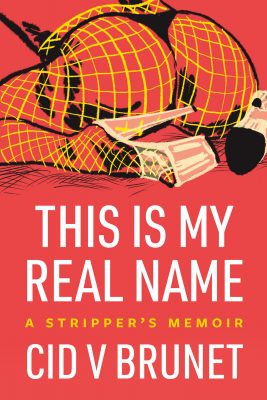Queer, anarchist, punk: Cid V Brunet does not, at first glance, fit the stripper stereotype. At second glance, though, they have something essential in common with the other “girls” in the club: a desire to make good money, and limited options for doing so.
Brunet also has both a keen eye and a way with words, making This Is My Real Name: A Stripper’s Memoir a smooth read studded with golden nuggets of deft description and clever turns of phrase. On a good night, for example, the “crowd is stamping and cheering. The bigger I smile and the more I blow kisses […] the more wildly the crowd responds, throwing bills, whistling, even pounding the stage. When I take out my tits, the bar erupts like I’ve scored a touchdown.”
On another occasion, they observe more experienced strippers using their “luxurious charm” to “cast a spell over the whole club. Men are hypnotized,” they write, “their wallets opening and closing like gills.” Brunet has real writing chops, and is at their best when using this kind of fresh image to pull the reader into vivid, immediate scenes, as when they describe a fellow stripper who is asleep in their shared motel room: “She is wearing a sleep mask with an embroidered weed leaf over each eye, like coins for the dead.”

This Is My Real Name
A Stripper's Memoir
Cid V Brunet
Arsenal Pulp Press
$22.95
paper
320pp
9781551528588
The narrative arc is a traditional bildungsroman. We follow Brunet (known by their work name “Michelle”) as they come to knowledge and maturity, in their case complete with stiletto heels, banana-flavoured condoms, and a baggie full of Percocet. It also follows the literary convention of ending with a marriage – in this case, a commitment ceremony for Brunet and their long-term boyfriend. It should be noted that the very open, supportive partnership between the two is one of the pleasures of the story, nicely disrupting the stereotype of sex workers mired in abuse.
There is a lot of repetition. Not much distinguishes one club from the other; few customers stand out from the crowd; among the hundreds of other women Michelle works with, there is only a handful of developed characters – in short, the background rather blurs into much of a muchness, without a lot of narrative tension or momentum. The fact that the reader keeps rolling through the story is a tribute to Brunet’s writerly skill.
The stripper memoir is well-trodden ground, and there is nothing startling in this one. But there is real pleasure to be had in the writing’s best moments, as when Brunet describes the hotel room they have rented with a couple of other strippers, “floor littered with heels and luggage, makeup and body products on all available surfaces,” looking “as if a stripper bomb exploded.”mRb






0 Comments